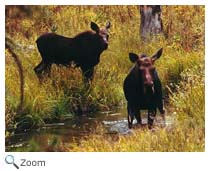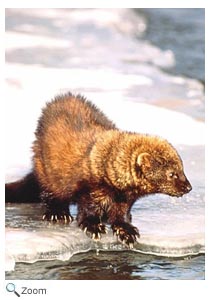Room to Roam
 Think about all the places you go during the week - to school, to the store, to the park - all of these places are important to you. They are your home range! Every animal species needs a certain amount of space to survive and thrive. The amount of space an animal uses on a regular basis is called its home range. Home ranges can stretch for many miles or they can be only a few feet. The size of a home range often depends on the size of an animal. Large animals, like the moose, need more space to survive than smaller animals like the chipmunk! Think about all the places you go during the week - to school, to the store, to the park - all of these places are important to you. They are your home range! Every animal species needs a certain amount of space to survive and thrive. The amount of space an animal uses on a regular basis is called its home range. Home ranges can stretch for many miles or they can be only a few feet. The size of a home range often depends on the size of an animal. Large animals, like the moose, need more space to survive than smaller animals like the chipmunk!
Moving Around
 Animals move around for a variety of reasons. They move for food, for shelter, to care for their young, to find a mate, and to escape predators. Some animals move seasonally from one location to another; this is migration. All animals move around within their habitat on a daily basis. The area an animal uses to meet its daily needs is its home range. Animals move around for a variety of reasons. They move for food, for shelter, to care for their young, to find a mate, and to escape predators. Some animals move seasonally from one location to another; this is migration. All animals move around within their habitat on a daily basis. The area an animal uses to meet its daily needs is its home range.
Having a home range is important for an animal's survival. They become familiar with their range. They know where the food and water is, where the danger is, and where the good hiding spots are. They also learn to identify when something has changed or invaded their home range. Many animals are as familiar with their home range as you are with your neighborhood! In fact, some animals are so attached to their home ranges that when they are removed from them, they will sometimes travel many miles to return!
No Place Like Home
 Some animals have one location in their home range, like a den or a nest, that is their home. They may move around their home range during the day or at night, but they always return to that one place to sleep! Other animals don't have a single place in their home range that is their home. They may rest wherever they can find a safe, comfortable spot! Other animals may have a few spots within their home range that they use to rest. Some animals have one location in their home range, like a den or a nest, that is their home. They may move around their home range during the day or at night, but they always return to that one place to sleep! Other animals don't have a single place in their home range that is their home. They may rest wherever they can find a safe, comfortable spot! Other animals may have a few spots within their home range that they use to rest.
|
| | |
Back Off
 Many animals, like the coyote, mark and defend some or all of their home range. When this happens, they have established a territory. When an animal establishes a territory, it usually only defends it against other members of its species. Many male animals will establish a territory and share it with more than one female but defend it against other males. This helps ensure that other males won't mate with the females in his home range. Many animals, like the coyote, mark and defend some or all of their home range. When this happens, they have established a territory. When an animal establishes a territory, it usually only defends it against other members of its species. Many male animals will establish a territory and share it with more than one female but defend it against other males. This helps ensure that other males won't mate with the females in his home range.
Private Property
 Bobcats are solitary animals, except during mating season. They mark their territory with urine, feces, scent markings, scratches and scrapes (piles of dirt and debris marked with scent). A male's home range may overlap with the home range of a couple of females and often another male. Females' home ranges usually don't overlap. Home ranges can vary in size from less than a square mile to more than 20 miles, depending on the season of the year and the geographic location. Bobcats are solitary animals, except during mating season. They mark their territory with urine, feces, scent markings, scratches and scrapes (piles of dirt and debris marked with scent). A male's home range may overlap with the home range of a couple of females and often another male. Females' home ranges usually don't overlap. Home ranges can vary in size from less than a square mile to more than 20 miles, depending on the season of the year and the geographic location.
Well Traveled
 The fisher is usually nocturnal. A fisher's home range is usually about ten square miles and may overlap with the home ranges of a number of other fishers. It uses scent to mark its territory. A fisher moves around its home range frequently, following well-used trails. It travels both on the ground and through the trees. The fisher makes its den in crevices, under bushes, in logs, and in trees.
|
 The fisher is usually nocturnal. A fisher's home range is usually about ten square miles and may overlap with the home ranges of a number of other fishers. It uses scent to mark its territory. A fisher moves around its home range frequently, following well-used trails. It travels both on the ground and through the trees. The fisher makes its den in crevices, under bushes, in logs, and in trees.
The fisher is usually nocturnal. A fisher's home range is usually about ten square miles and may overlap with the home ranges of a number of other fishers. It uses scent to mark its territory. A fisher moves around its home range frequently, following well-used trails. It travels both on the ground and through the trees. The fisher makes its den in crevices, under bushes, in logs, and in trees. 




